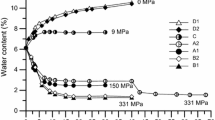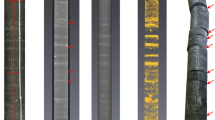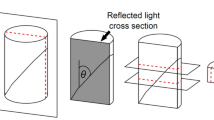Abstract
Several experimental methods are used to investigate the swelling capacity and transport properties of re-sealed macro-cracked Callovo–Oxfordian (COx) claystone, particularly in the absence of confining pressure. Six COx claystone samples from four different geological locations of the Bure basin (France) are tested, five of which are macro-cracked and one remains intact. Sample swelling occurs, during re-hydration with liquid water, leading to the measurement of an apparent swelling pressure. The latter is continuously recorded with a dedicated device. The asymptotic apparent swelling pressure of macro-cracked UT (transitional unit) COx is approximately 1 MPa, while it varies from 3 to 5 MPa for macro-cracked UA (clayey unit) COx. Quantitative X-ray diffraction (QXRD) analysis demonstrates that the amount of smectite, which is a swelling clay, is weakly correlated with apparent swelling pressure. Surprisingly, the interstratified illite/smectite with lower smectite content is highly correlated to apparent swelling pressure. Nitrogen isotherms data imply that the Gurvich total pore volume (VGurvich) and specific surface area (SSA) are highly linearly correlated with the low smectite content interstratified phase. This means that the distribution of smectite strongly affects the swelling capacity of COx. Moreover, nitrogen sorption is an easier and more effective technique than QXRD for assessing COx swelling capacity, since both VGurvich and SSA have been proven as effective indicators. For both UT and UA COx, self-sealing can cause significant reductions in water permeability (Kw). In particular, UA COx shows higher sealing efficiency and faster kinetics compared to UT COx. After sealing, the equivalent crack aperture (calculated from Poiseuille’s law) decreases from tens of microns to less than 1 micron. According to the gas breakthrough tests, the gas breakthrough pressure (GBP) of re-sealed macro-cracked COx is of the same order of magnitude as the equivalent capillary pressure of residual crack. This indicates that the gas migration in the re-sealed cracked COx claystone mainly occurs through the residual crack and is ‘a priori’ controlled by capillary processes.
Highlights
-
A dedicated device was designed to study the transport and swelling properties of a sealed COx claystone under low confinement.
-
The apparent swelling pressure and water permeability were continuously recorded during the sealing test due to water injection in fractures.
-
Water permeability of samples decreased by orders of magnitude to almost meet the intact material permeability.
-
Gas breakthrough experiments performed on sealed samples evidenced gas flow through the residual cracks.













Similar content being viewed by others
References
Al-Ani T, Sarapää O (2008) Clay and clay mineralogy. Geological survey of Finland
Amann-Hildebrand A, Dietrichs JP, Krooss BM (2016) Effective gas permeability of Tight Gas Sandstones as a function of capillary pressure—a non-steady-state approach. Geofluids 16:367–383
Anderson RL, Ratcliffe I, Greenwell HC et al (2010) Clay swelling—a challenge in the oilfield. Earth Sci Rev 98:201–216
ANDRA (2005) Dossier 2005 Argile. ANDRA, Collection les Rapports. https://www.andra.fr/sites/default/files/2018-02/265.pdf
Bernier F, Li XL, Bastiaens W et al (2007) SELFRAC: Fractures and Self-healing within the excavation disturbed zone in clays. In: Final Technical Publishable Report EUR 22585, European Commission
Cariou S, Duan Z, Davy CA et al (2012) Poromechanics of partially saturated COx argillite. Appl Clay Sci 56:36–47
Chen GJ, Maes T, Vandervoort F et al (2014) Thermal Impact on damaged boom clay and opalinus clay: permeameter and isostatic tests with μCT scanning. Rock Mech Rock Eng 47:87–99
Chen W, Han Y, Agostini F et al (2021) Permeability of a macro-cracked concrete effect of confining pressure and modelling. Materials 14:862. https://doi.org/10.3390/ma14040862
Conil N, Talandier J, Djizanne H et al (2018) How rock samples can be representative of in situ condition: a case study of Callovo-Oxfordian claystones. J Rock Mech Geotech Eng 10:613–623
Davy CA, Skoczylas F, Barnichon JD, Lebon P (2007) Permeability of macro-cracked argillite under confinement: gas and water testing. Phys Chem Earth Parts a/b/c 32:667–680
de La Vaissière R, Armand G, Talandier J (2015) Gas and water flow in an excavation-induced fracture network around an underground drift: a case study for a radioactive waste repository in clay rock. J Hydrol 521:141–156
Delvaux B (1992) Morphology, texture, and microstructure of halloysitic soil clays as related to weathering and exchangeable cation. Clays Clay Miner 40:446–456. https://doi.org/10.1346/CCMN.1992.0400409
Duan Z, Skoczylas F, Wang C, Talandier J (2021) Hydric cycle impacts on COx argillite permeability and young’s modulus. Rock Mech Rock Eng 54:1129–1147. https://doi.org/10.1007/s00603-020-02258-1
Giot R, Auvray C, Talandier J (2019) Self-sealing of claystone under X-ray nanotomography. Geol Soc London Spec Publ 482:213–223
Horseman ST, Harrington JF, Sellin P (1999) Gas migration in clay barriers. Eng Geol 54:139–149
Lahn L, Bertier P, Seemann T, Stanjek H (2020) Distribution of sorbed water in the pore network of mudstones assessed from physisorption measurements. Microporous Mesoporous Mater. https://doi.org/10.1016/j.micromeso.2019.109902
Liu J-F, Davy CA, Talandier J, Skoczylas F (2014) Effect of gas pressure on the sealing efficiency of compacted bentonite–sand plugs. J Contam Hydrol 170:10–27
M’Jahad S, Davy CA, Skoczylas F, Talandier J (2017) Characterization of transport and water retention properties of damaged callovo-oxfordian claystone. Geol Soc London Spec Publ 443:159–177
Marschall P, Horseman S, Gimmi T (2005) Characterisation of gas transport properties of the opalinus clay, a potential host rock formation for radioactive waste disposal. Oil Gas Sci Technol Rev IFP 60:121–139
Meier LP, Kahr G (1999) Determination of the cation exchange capacity (CEC) of clay minerals using the complexes of copper(II) Ion with triethylenetetramine and tetraethylenepentamine. Clays Clay Miner 47:386–388
Menaceur H, Delage P, Tang AM, Talandier J (2016) The status of water in swelling shales: an insight from the water retention properties of the callovo-oxfordian claystone. Rock Mech Rock Eng 49:4571–4586
Mitchell JK, Soga K (2005) Fundamentals of soil behavior, 3rd edn. Wiley, New Jersey
Ongari D, Boyd PG, Barthel S et al (2017) Accurate characterization of the pore volume in microporous crystalline materials. Langmuir 33:14529–14538
Pimentel E (2015) Existing methods for swelling tests—a critical review. Energy Procedia 76:96–105
Rouquerol J, Llewellyn P, Rouquerol F (2007) Is the bet equation applicable to microporous adsorbents? Studies in surface science and catalysis. Elsevier, pp 49–56
Saiyouri N, Hicher P-Y, Tessier D (2000) Microstructural approach and transfer water modelling in highly compacted unsaturated swelling clays. Mech Cohes Frict Mater 5:41–60
Saiyouri N, Tessier D, Hicher P-Y (2004) Experimental study of swelling in unsaturated compacted clays. Clay Miner 39:469–479
Seemann T, Bertier P, Krooss BM, Stanjek H (2017) Water vapour sorption on mudrocks. Geol Soc London Spec Publ 454:201–233
Song Y, Davy CA, Troadec D et al (2015) Multi-scale pore structure of COx claystone: towards the prediction of fluid transport. Mar Pet Geol 65:63–82
Song Y, Davy CA, Bertier P, Troadec D (2016) Understanding fluid transport through claystones from their 3D nanoscopic pore network. Microporous Mesoporous Mater 228:64–85
Song Y, Davy CA, Bertier P et al (2017) On the porosity of COx claystone by gas injection. Microporous Mesoporous Mater 239:272–286
Thommes M, KatieA C (2014) Physical adsorption characterization of nanoporous materials: progress and challenges. Adsorption 20:233–250
Van Geet M, Bastiaens W, Ortiz L (2008) Self-sealing capacity of argillaceous rocks: review of laboratory results obtained from the SELFRAC project. Phys Chem Earth Parts a/b/c 33:S396–S406
Zhang C-L (2011) Experimental evidence for self-sealing of fractures in claystone. Phys Chem Earth Parts a/b/c 36:1972–1980
Zhang C-L, Rothfuchs T (2004) Experimental study of the hydro-mechanical behaviour of the callovo-oxfordian argillite. Appl Clay Sci 26:325–336
Zhang C-L, Rothfuchs T (2008) Damage and sealing of clay rocks detected by measurements of gas permeability. Phys Chem Earth Parts a/b/c 33:S363–S373
Zhang Y, Lebedev M, Sarmadivaleh M et al (2016) Swelling effect on coal micro structure and associated permeability reduction. Fuel 182:568–576
Zhang F, Cui YJ, Conil N, Talandier J (2020) Assessment of swelling pressure determination methods with intact callovo-oxfordian claystone. Rock Mech. https://doi.org/10.1007/s00603-019-02016-y
Zhou X, Liu D, Bu H et al (2018) XRD-based quantitative analysis of clay minerals using reference intensity ratios, mineral intensity factors, rietveld, and full pattern summation methods: a critical review. Solid Earth Sci 3:16–29
Acknowledgements
The authors are grateful to Andra (French Agency for Nuclear Waste Management) for providing samples and funding this research program. We also acknowledge the Qmineral Company for its assistance in Quantitative XRD and CEC analysis.
Author information
Authors and Affiliations
Corresponding author
Ethics declarations
Conflict of interest
The authors declare that there is no conflict of interest linked to this study.
Additional information
Publisher's Note
Springer Nature remains neutral with regard to jurisdictional claims in published maps and institutional affiliations.
Appendix
Appendix
1.1 Quantitative X-ray Diffraction (QXRD)
To determine the bulk mineralogical composition, first, the representative sample of claystone are crushed manually into powders, combined with internal standard (0.2 g/g Al2O3 serving as the accuracy control). The powders are subsequently micronized, milled in ethanol and spray dried. After that, the powders are loaded in a sample holder by side loading and measured by X-ray diffraction (in this study, a CuKα radiation was used). The subsequent weight quantification of each mineral can be performed based on the Rietveld method (Zhou et al. 2018). For the detailed 2:1 clay minerals analysis, a chemical treatment was first used to remove cementing agents of powders, the powder size is selectively separated to below 2 µm by means of centrifugation. Each type of powders will be saturated with Ca2+. Thus, all expandable clay mineral cations are exchanged to Ca2+ and this greatly facilitates identification and quantification of the different clay mineral species. The oriented preparations are made by sedimentation on a porous ceramic plate. The preparations yield highly oriented clay particles. They are subsequently analyzed by X-ray diffraction for the measurement of the first reflections (001) of the clay minerals.
Generally, the accuracy of non-clay mineral composition can be controlled within 1%, while it is difficult to assess the accuracy of clay mineral composition due to the lack of standard materials. The bias of XRD results is mainly associated with the mistaken of quantifying illite as smectite (Seemann et al. 2017).
1.2 Cation Exchange Capacity
The representative part of samples (around 5 g) is retrieved from different cores, and first dried at 110 ◦C and then weigh noted. All samples were subsequently stirred and dispersed in ultrapure water with Co (III)-hexamine, following the method described in (Meier and Kahr 1999). The exchange progress was accomplished by means of placing the sample and solution in an overhead shaker until the exchange reaction was completed. All samples were then homogenized after ultrasonic treatment and the absorption of the supernatant liquid was measured using a spectrophotometer. The cation exchange capacity of each sample was derived by the difference of concentration between the solution and supernatant liquid. For each sample, the procedure was repeated several times to increase the accuracy of the results. The detailed methodology was elaborated interpreted in the literature, for instance, (Meier and Kahr 1999). The value of CEC is quantified in milligram equivalents (meq) of exchangeable cations per 100 g of the dry sample or in millimoles of exchangeable cations per grams (mmol/g) of dry sample (Song et al. 2017).
1.3 Nitrogen Physisorption
For each measurement, the representative COx sample (2–4 g) is first manually crushed and sieved to obtain fragments of 63–400 µm size. All the treated sample fragments are degassed for 12 h, then heated in a vacuum environment at 130 ℃ for at least 12 h. The adsorption/desorption measurement is carried out on a Micromeritics ASAP2020 machine. Using nitrogen at a constant temperature of 77 k, 31 relative pressure points during adsorption and 24 relative pressure points during desorption are recorded, within a relative pressure interval of 0.001–0.995 p/p0. The equilibration is regarded as the pressure change over 10 s is less than 0.01% of the average pressure during the latter interval. And the saturation pressures (i.e., p0) are re-calibrated independently for each step.
Rights and permissions
About this article
Cite this article
Wang, C., Talandier, J. & Skoczylas, F. Swelling and Fluid Transport of Re-sealed Callovo–Oxfordian Claystone. Rock Mech Rock Eng 55, 1143–1158 (2022). https://doi.org/10.1007/s00603-021-02708-4
Received:
Accepted:
Published:
Issue Date:
DOI: https://doi.org/10.1007/s00603-021-02708-4




